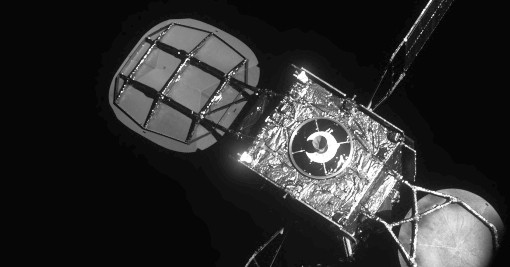Two commercial satellites just docked in space for the first time
Two commercial satellites have docked in orbit as part of a pioneering satellite-servicing mission. If the rest of the mission is successful, it should give an ailing communications satellite a new lease on life, and it could kickstart an industry that keeps space junk from clogging the skies.
“This is the first time in history, a docking has ever been performed with a satellite that was not pre-designed with docking in mind,” said Joe Anderson, a vice president at Space Logistics, in a press conference. Space Logistics is the Northrop Grumman subsidiary that oversaw the mission. “This is the first time two commercial satellites have ever docked.”
On February 25th, Northrop Grumman’s Mission Extension Vehicle (MEV-1) docked with a communications satellite, Intelsat 901. After nearly 19 years in space, Intelsat 901 is running low on fuel. If nothing was done, people on the ground would have lost the ability to actively control the satellite. So a few years ago, Intelsat decided to sign on to a mission that would send another satellite to extend the life of its ailing spacecraft by another five years.
MEV-1 launched in October 2019, and it took about three months for it to reach Intelsat 901. The satellites met up in what’s called a “graveyard orbit,” which is a place where defunct satellites are put so that they won’t interfere with active satellites. Now that the two have been linked, MEV-1 will take over all maneuvering and navigation. Sometime in March, it will move Intelsat 901 out of the graveyard orbit so it can return to operations. After about five years, MEV-1 will move Intelsat 901 back to the graveyard orbit where the communications satellite will be decommissioned. At that point, MEV-1 could potentially go on to service another satellite.
The mission is an exciting milestone for the industry, which has been working toward uncrewed satellite repair for years. Being able to fix satellites in orbit could save satellite companies a lot of money and potentially reduce the amount of space junk that’s circling Earth. Previous missions to move or service satellites have relied on crewed missions, such as multiple trips to service the Hubble Space Telescope.
Northrop Grumman isn’t the only company trying to move into satellite repair. Astroscale, a private company focused on space debris removal, plans to launch a test mission this year, during which two satellites will practice docking in space using magnetic plates. It hopes to develop a way to latch on to defunct satellites and guide them into an orbit where they will ultimately burn up in Earth’s atmosphere.
Northrop Grumman has another mission, MEV-2, that is expected to launch later this year, which will also service an Intelsat satellite. The company is still working on its next-generation satellite servicing fleet. That fleet will feature smaller Mission Extension Pods, which are designed to offer smaller fixes than the MEVs and will be deployed by a robotic spacecraft.
You may be interested

'Incredible' Netflix Western leaves fans in floods of tears
admin - Apr 16, 2025[ad_1] Viewers can't believe "no one has heard" of this Western film with an A-list cast [ad_2] Source link

'Greatest gangster movie ever made' is all-time classic that's 'better than The Godfather'
admin - Apr 16, 2025[ad_1] It has a 94% rating on Rotten Tomatoes and is streaming on Amazon Prime Video, Apple TV and Google…

New British war film out on Friday is best since Dunkirk
admin - Apr 16, 2025[ad_1] A new British war film out in cinemas on Friday is the best since Dunkirk. [ad_2] Source link
Leave a Comment
You must be logged in to post a comment.





















